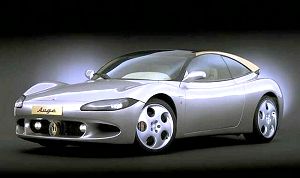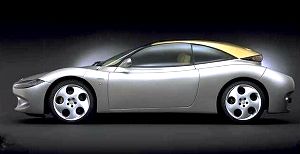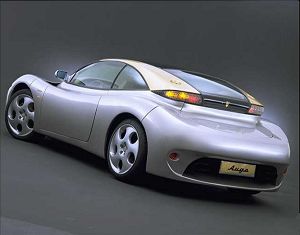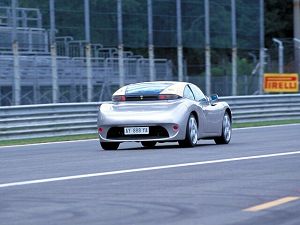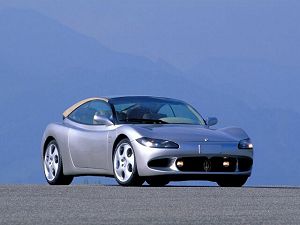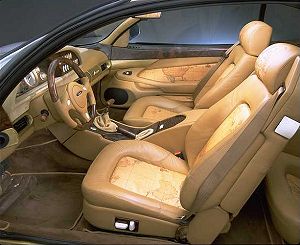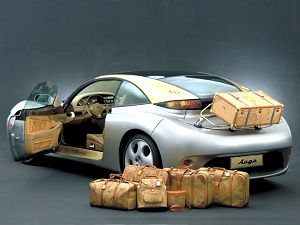| Official Auge Press Release
"Auge... a cold wind which blows along the Côte d' Azure." |
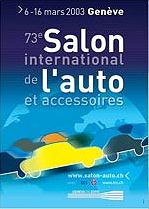 |
|
|
|
NOTE: Maserati have severed all connections with the Auge project. Castagna made a agreement with Sig Alzati and the previous ownership, but that agreement does not continue with the current ownership. |
|||
73rd Salon International de l'Auto - Geneva 2003 |
|||
A stunning new design, the Auge, based on the platform of the Maserati Quattroporte Evoluzione. The Auge was a design concept by the highly talented Gioacchino Acampora as the basis of his degree in architecture at Politecnico di Milano in 1996. |
|||
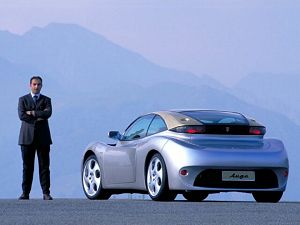 |
|||
|
Therefore, the Auge is not just a modern answer to the style for a possible new taste of our times, but a careful analysis of history and what represents the traditional style one would expect in a luxury coupe. But my research would not really be complete without a serious analysis of methods that were used to govern the creative and productive process. If it is true that to designing always means to respect the 'shape-function' dogma, I think that nowadays it is indispensable to add the concepts of methodological and economic-productive planning to this rule. |
|||
|
Without assuming to find a definite answer, the Auge is hence an attempt to answer the questions: " What must cars that belong to a product group called 'niche products' be like?" and "How do they have to be made?". To find out what such production would entail today, a method of examination is to analyse a niche group that is one below that in the automotive industry, a group of special-built cars that were very famous at the end of the fifties. It is not only a nostalgic inclination for the fantasy expressed in those years or the wish for some 'dolce vita', but the conviction that to modernise methods for introducing a new product that fulfils all demands of today's market in every respect, i.e. more and more diversified products but with the best guaranteed quality standard - in short: a high-quality product made in serious way. |
|||
To arrive at such an aesthetic end result has meant to try to recover the naturalness of the creative walk. So computer-science devices were only used at the end of the process and developers did not avoid going to the drawing board to eliminate the risk of creating a shape that would be far too mathematical: Only the human touch can lead to natural dimensioning donating the magic of an object that does not age prematurely because is completely revealed in its appearance. |
|||
The exterior is characterised by large wheels (MOMO), which due to their dimension (20 inches) help to slim the flank and bring the car as a whole into proportion. The straight belt line, a true dynamic sign, moves upwards and justify the unusual position of the rear lights. It also marks the transparent space of the interior: it is completely made of glass and it has two "blades" of brushed brass sheeting to cover the tubular structure of the roof. The intention of this design was to use it as a symbol for most skilful abilities of "panel beaters" who shape the metal material. |
|||
The car's new colour scheme is generated by the effect of the contrast from brass, a warm colour often used on specialist cars in the past, to the intense cold effect of employing a particular silver varnish, which has been developed specifically for this model (PPG). The aim was to put together a folder with a collection of typical colours to combine and test out other two-colour effects. As a result 'Dragon Red' was coupled with aluminum blades, and this combination was then used for the presentation of the race version. |
|||
Everything is made to respect the chromatic tradition of the brand. The dashboard is dominated by the typical instrumentation used in quality cars, here with silver settings to reflect a certain aeronautical flair: also the function control elements are made of classic materials used in the special cars during the thirties: ivory, cameos, coral and lapis-lazuli. These elements are carved by the most skilful craftsmen specialised in sculpturing such materials (La Vallèe). Hidden, and only noticeable through the presence of three monitors, there is the second aspect of the duality of this cockpit, it is in fact state of the art of travelling: a multimedia system (Alpine and Philips). |
|||
The cockpit is enclosed by a completely transparent cover allowing passengers to see the external panorama, a revival of that typical sense of freedom of the spiders. The transparent roof is based on "glass-room technology", in other words a connection of two tempered glasses with a high absorption factor for infrared and ultraviolet rays. The air is removed to avoid the transmission of heat, noise and to eliminate the formation of condensation typical at low temperatures. The rear luggage compartment comes with a complete set of four suitcases and a porta abiti, a bag that holds a spare wheel (inflatable type) and another bag with tools for small repairs (Prima Classe). |
|||
| TECHNICAL DATA - The Auge | |
| Body type | 2-door 2+2 Coupé |
| Engine | Front engined V8 cylinder @ 90° |
| Distribution | Four overhead camshafts, four valves per cylinder |
| Bore and stroke | ? mm X ? mm |
| Engine capacity | 3219 cc |
| Maximum power | 450-bhp @ ? rpm |
| Turbochargers | 2 water-cooled IHI turbochargers with intercoolers |
| Induction system | Weber-Marelli multipoint electronic injection |
| Ignition | Direct electronic ignition with individual coils |
| Transmission | Rear wheel drive |
| Gearbox | 5 speed and reverse |
| Chassis | Aluminium with carbon-fibre |
| Brakes | Ventilated disc brakes on all four wheels with ABS |
| Tyres | Front:- 245/45ZR20 Rear:- 275/35ZR20 |
| Wheelbase | 2550 mm |
| Overall length | 4550 mm |
| Overall width | 1920 mm |
| Overall height | 1330 mm |

|
To enter Enrico's Maserati Pages CLICK HERE! Copyright: Carrozzeria Castagna - © 2003-2004. All rights reserved. |
